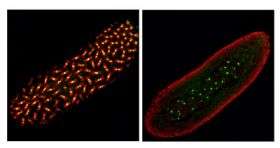Researchers describe for first time how some bacteria kill males: They first invade the mother

(PhysOrg.com) -- Many groups of bacteria are known as "male killers" -- they target and kill just the males of a host species. Now, a Cornell scientist has helped describe for the first time just how certain male-killing bacteria manage to specifically kill off males of a parasitic wasp.
The bacteria Arsenophonus nasoniae infect both sexes of the parasitic wasp Nasonia vitripennis but target the males, killing more than 70 percent, said Patrick Ferree, Cornell postdoctoral fellow in molecular biology and genetics.
Ferree and his University of Rochester collaborator John Werren report on this mechanism in the Sept. 23 issue of Current Biology.
Arsenophonus inhibits the ability of male eggs to develop normally into embryos by infecting mother wasps. "Arsenophonus resides in the tissues around the developing eggs in the infected mother but not in the egg itself, so the bacteria likely secrete an unknown substance that penetrates the eggs to affect embryonic development," said Ferree. The result of the infection is that the mother wasps have broods with many more females than males.
Unlike previously described mechanisms that explain sex-ratio imbalances in other insect species, Arsenophonus targets small cellular organelles called centrosomes in the developing male wasps. Centrosomes help direct mitosis, which is critical for development and involves the coordinated segregation of chromosomes into new cells.
But why are only males vulnerable to Arsenophonus? Female Nasonia develop from eggs that are fertilized by sperm. The females, therefore, have centrosomes from their mother as well as their father's sperm. Males, on the other hand, develop from unfertilized eggs and therefore do not have any sperm-derived centrosomes -- Arsenophonus has evolved to be able to destroy the egg-derived centrosomes, rendering male embryos incapable of developing. The sperm-donated centrosomes in the female wasp embryos, however, are not vulnerable to Arsenophonus infection.
"This is an example of a sex-ratio distorter that has taken advantage of a specific type of host reproductive machinery," Ferree said. "They have gone in and exploited whatever sex difference they can -- which in this case is the use of these egg-derived centrosomes.
"Male killing is advantageous for the bacteria because they are only transmitted through female wasps -- and it is believed that this helps the females to have more resources and, ultimately, propagate more bacteria."
The research, said Ferree, has implications for better understanding host-pathogen interactions and, developmentally, how these special egg-derived centrosomes are formed. "No one had previously knocked out egg-derived centrosomes to see what the effect was, and I think these bacteria are the first to perform that experiment," Ferree said. "Given the variety of arthropods [insects] in the world, it is fascinating to imagine how many more types of bacterial reproductive mechanisms are out there."
The research (published in Current Biology [2008] 18: 1409--1414) was supported by a Ruth L. Kirschstein National Research Service Award and the National Institutes of Health.
Provided by Cornell University
















